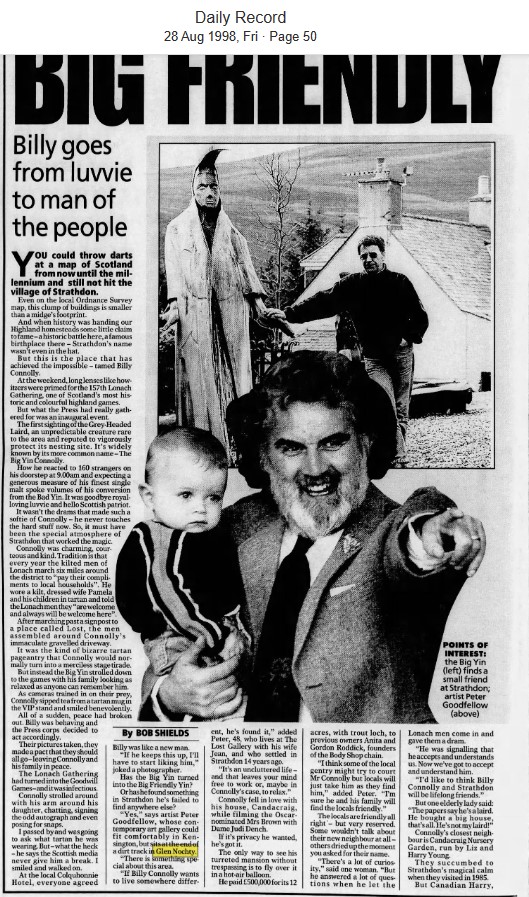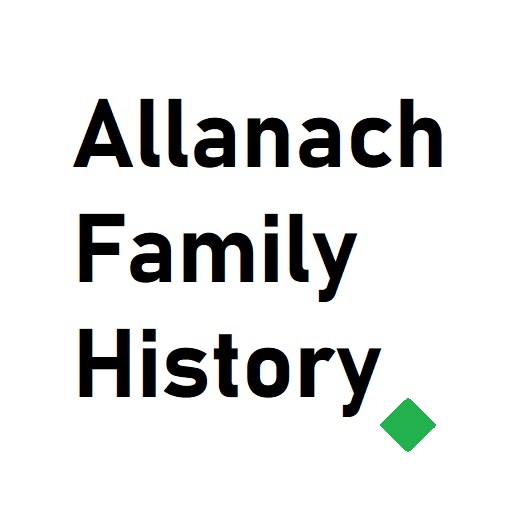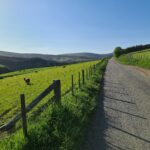Glen Nochty One-Place Study
Glen Nochty One-Place Study
About this study
A one-place study is one which considers people and families in their physical and social context in any location across the globe. This could cover any area including a town, village, suburb, estate, a single street, or even an individual building.
This particular study focuses on the inhabitants and dwelling places in Glen Nochty in Strathdon parish, Aberdeenshire.
Despite the glen’s remoteness and relatively small population (perhaps 15-25 people, depending on season), it has a deep history and some fascinating stories associated with it.
Given the Allanach family’s historical links with the crofts and farms in the glen, it seemed a natural extension of the one name study, and a place to host the research collected so far.
The study is far from complete, and I hope that many new documents and photos come to light that means the study can get continually updated.
One of the drivers behind this project has been to record the sites before they vanish from the landscape. Despite some of the crofts and farms being lived spaces just 100 years ago, it has been remarkable to see how quickly the forces of nature reclaim these buildings; forestation in parts of the glen has hastened this process further.
It was also to give the Glen’s many living descendants a sense of what the homes of their ancestors look like today. Some now live in America, Canada, Australia or New Zealand, from where travel to Glen Nochty might be cost prohibitive, and for them I have included some short videos so they can get a sense of what its like to stand facing their ancestor’s former home – the sights and sounds.
As the photos below show, this has been, and continues to be, a fun project to undertake – where consulting 18th century maps on forest tracks and flying drones over the moors often proved more useful than time spent in a library!
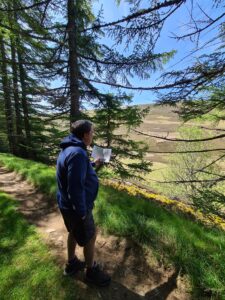

I hope you find this study useful, and if you have anything to add, correct or comment on, please get in touch!
About Glen Nochty
Glen Nochty is ‘a most beautiful example of a Highland glen’. It frequently attracts the word ‘remote’ but hosts a thriving community, even to this day. Whilst the population has much declined, it has a rich history from possible Roman and Picts, through to Jacobites and Clans, through to whisky smuggling and agriculture of the Victorian Period into managed estates of the twentieth century.
Location of Glen Nochty

Map of Area
Glen Nochty is not a defined area but can be said to include the glen starting at Bellabeg and Lost Farm and moving up to Torrancroy where the glen splits into a side glen where the Water of Nochty flows from Duffdefiance down into the main glen, and also a pass between Moss Hill and Ladylea Hill leading through to Badenyon and Glenbuchat.
Starting at Bellabeg and walking up the Glen to Torrancroy and then walking up past Lost Gallery to Duffdefiance would take you 2h12 mins to cover the 6.85km.

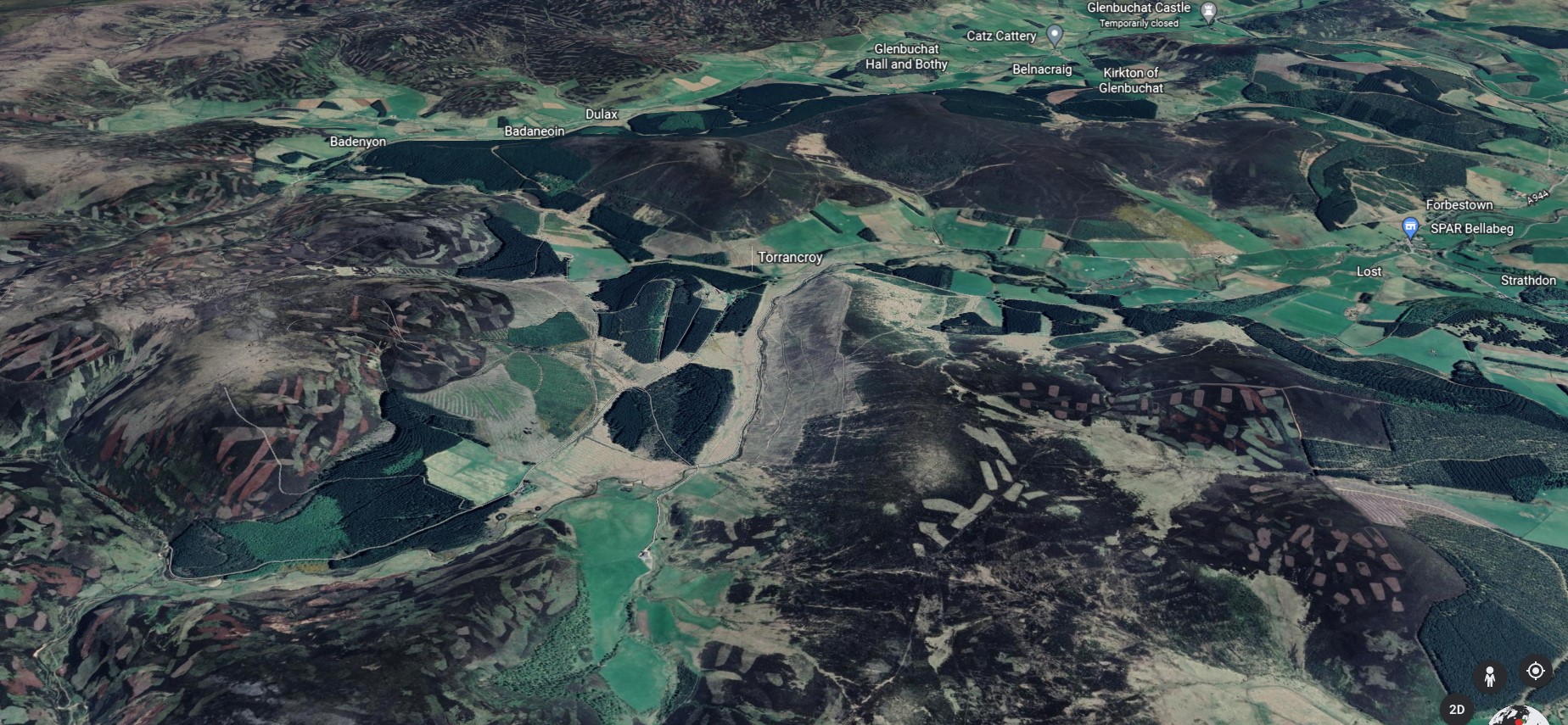
List of places and links to their listings
Click on the name to show the page for the individual listing of the settlement. The list below follows roughly the locational order of the places from the top of the Glen down through to Lower Nochty and to Bellabeg.
‘A’ marked red indicates an Allanach is documented as having once resided at this place. ‘1747’ marked red means that the placename was stated on Roys Military Map in 1747. For the years 1841-1921, being marked red means that the place was occupied at the date of that census year, blue means it is marked as unoccupied in the census and grey means not mentioned. ‘1966’ marked red indicates the place being mentioned on the 1966 electoral roll. Please note that only place names linked through to a listing have so far been researched.
- Duffdefiance – A – 1747 – 1841 – 1851 – 1861 – 1871 – 1881 – 1891 – 1901 – 1911 – 1921 – 1966
- Righorach – A – 1747 – 1841 – 1851 – 1861 – 1871 – 1881 – 1891 – 1901 – 1911 – 1921 – 1966
- (West) Aldahuie – A – 1747 – 1841 – 1851 – 1861 – 1871 – 1881 – 1891 – 1901 – 1911 – 1921 – 1966
- East Aldahuie – A – 1747 – 1841 – 1851 – 1861 – 1871 – 1881 – 1891 – 1901 – 1911 – 1921 – 1966
- Upper Tolduquhill – A – 1747 – 1841 – 1851 – 1861 – 1871 – 1881 – 1891 – 1901 – 1911 – 1921 – 1966
- (Nether) Tolduquhill – A – 1747 – 1841 – 1851 – 1861 – 1871 – 1881 – 1891 – 1901 – 1911 – 1921 – 1966
- Finnygauld – A – 1747 – 1841 – 1851 – 1861 – 1871 – 1881 – 1891 – 1901 – 1911 – 1921 – 1966
- Haugh – A – 1747 – 1841 – 1851 – 1861 – 1871 – 1881 – 1891 – 1901 – 1911 – 1921 – 1966
- Auchernach – A – 1747 – 1841 – 1851 – 1861 – 1871 – 1881 – 1891 – 1901 – 1911 – 1921 – 1966
- Rhinstock – A – 1747 – 1841 – 1851 – 1861 – 1871 – 1881 – 1891 – 1901 – 1911 – 1921 – 1966
- Torrancroy – A – 1747 – 1841 – 1851 – 1861 – 1871 – 1881 – 1891 – 1901 – 1911 – 1921 – 1966
- Newtown – A – 1747 – 1841 – 1851 – 1861 – 1871 – 1881 – 1891 – 1901 – 1911 – 1921 – 1966
- Ladylye – A – 1747 – 1841 – 1851 – 1861 – 1871 – 1881 – 1891 – 1901 – 1911 – 1921 – 1966
- Blairnamuick – A – 1747 – 1841 – 1851 – 1861 – 1871 – 1881 – 1891 – 1901 – 1911 – 1921 – 1966
- Invernettie – A – 1747 – 1841 – 1851 – 1861 – 1871 – 1881 – 1891 – 1901 – 1911 – 1921 – 1966
- Corryhole – A – 1747 – 1841 – 1851 – 1861 – 1871 – 1881 – 1891 – 1901 – 1911 – 1921 – 1966
- Corriebreck – A – 1747 – 1841 – 1851 – 1861 – 1871 – 1881 – 1891 – 1901 – 1911 – 1921 – 1966
- Tornagown – A – 1747 – 1841 – 1851 – 1861 – 1871 – 1881 – 1891 – 1901 – 1911 – 1921 – 1966
- Belnaboddach – A – 1747 – 1841 – 1851 – 1861 – 1871 – 1881 – 1891 – 1901 – 1911 – 1921 – 1966
- Ledmacoy – A – 1747 – 1841 – 1851 – 1861 – 1871 – 1881 – 1891 – 1901 – 1911 – 1921 – 1966
- Coull of Ledmacoy – A – 1747 – 1841 – 1851 – 1861 – 1871 – 1881 – 1891 – 1901 – 1911 – 1921 – 1966
- Labourer’s Bothy – A – 1747 – 1841 – 1851 – 1861 – 1871 – 1881 – 1891 – 1901 – 1911 – 1921 – 1966
- Cummerton – A – 1747 – 1841 – 1851 – 1861 – 1871 – 1881 – 1891 – 1901 – 1911 – 1921 – 1966
- Drumnettie – A – 1747 – 1841 – 1851 – 1861 – 1871 – 1881 – 1891 – 1901 – 1911 – 1921 – 1966
- Drumallin – A – 1747 – 1841 – 1851 – 1861 – 1871 – 1881 – 1891 – 1901 – 1911 – 1921 – 1966
- Howe – A – 1747 – 1841 – 1851 – 1861 – 1871 – 1881 – 1891 – 1901 – 1911 – 1921 – 1966
- Bunobak – A – 1747 – 1841 – 1851 – 1861 – 1871 – 1881 – 1891 – 1901 – 1911 – 1921 – 1966
- Finnylost – A – 1747 – 1841 – 1851 – 1861 – 1871 – 1881 – 1891 – 1901 – 1911 – 1921 – 1966
- Lost – A – 1747 – 1841 – 1851 – 1861 – 1871 – 1881 – 1891 – 1901 – 1911 – 1921 – 1966
- Rinnaha – A – 1747 – 1841 – 1851 – 1861 – 1871 – 1881 – 1891 – 1901 – 1911 – 1921 – 1966
- Parkhouse – A – 1747 – 1841 – 1851 – 1861 – 1871 – 1881 – 1891 – 1901 – 1911 – 1921 – 1966
Meaning of name
Glen Nochty literally means valley of the river Nochty. You may also see the spelling ‘noughty’ in older texts.
A trip up the Glen in pictures
Starting in the village centre of Bellabeg/ Strathdon, turning right up past the post office/ SPA, along past Ledmacoy and turning into the side Glen up to Lost Gallery.

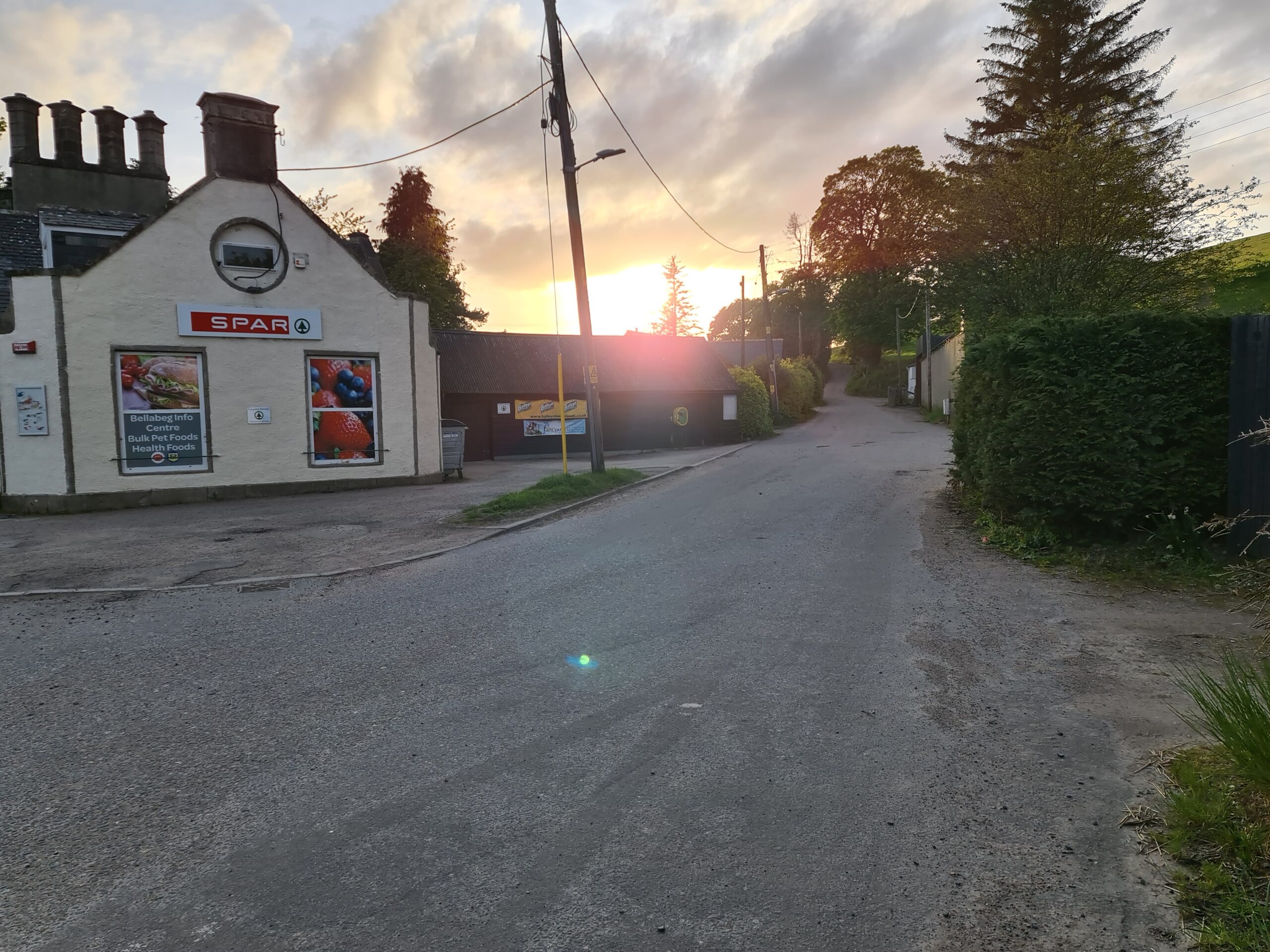
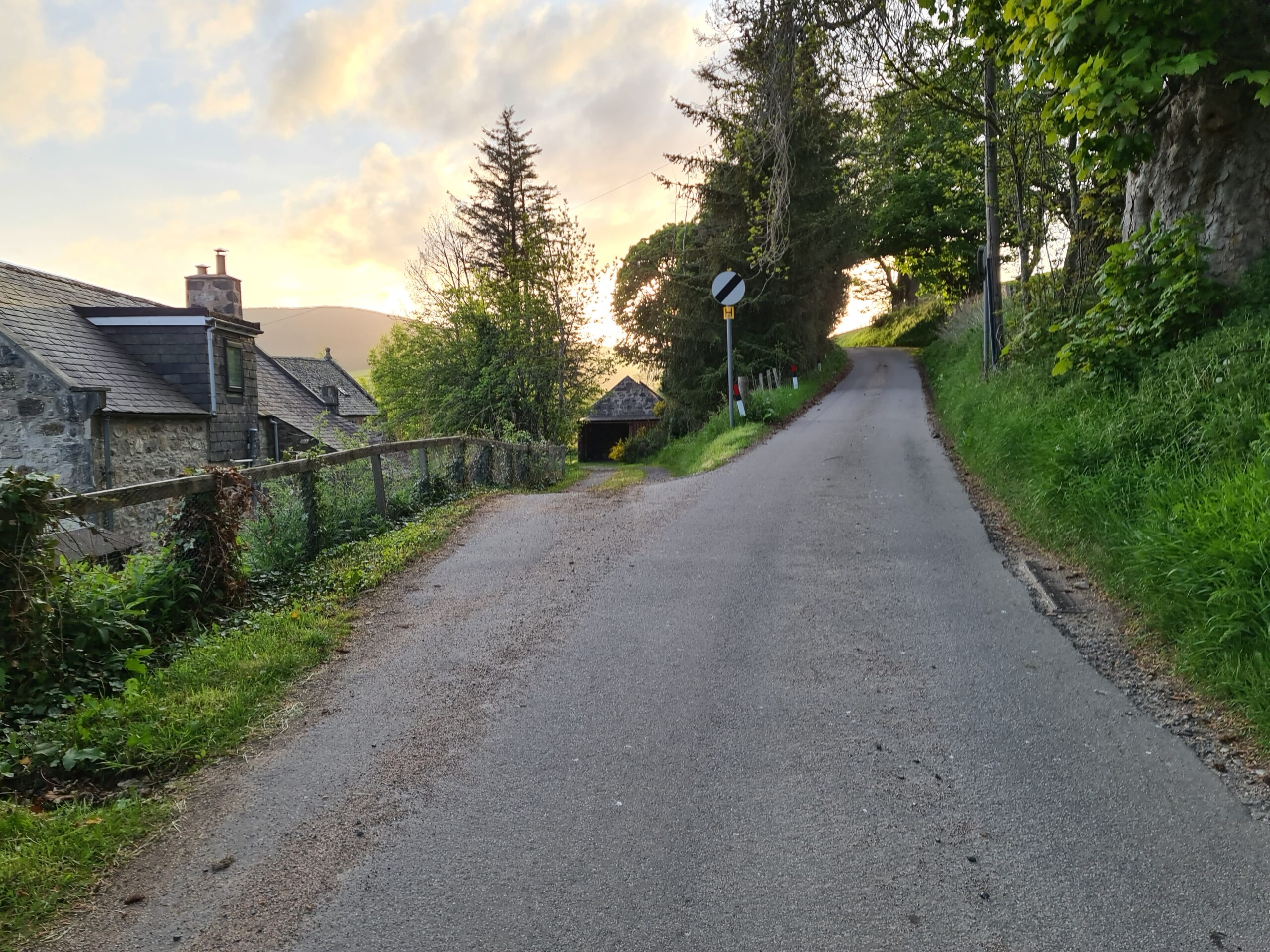
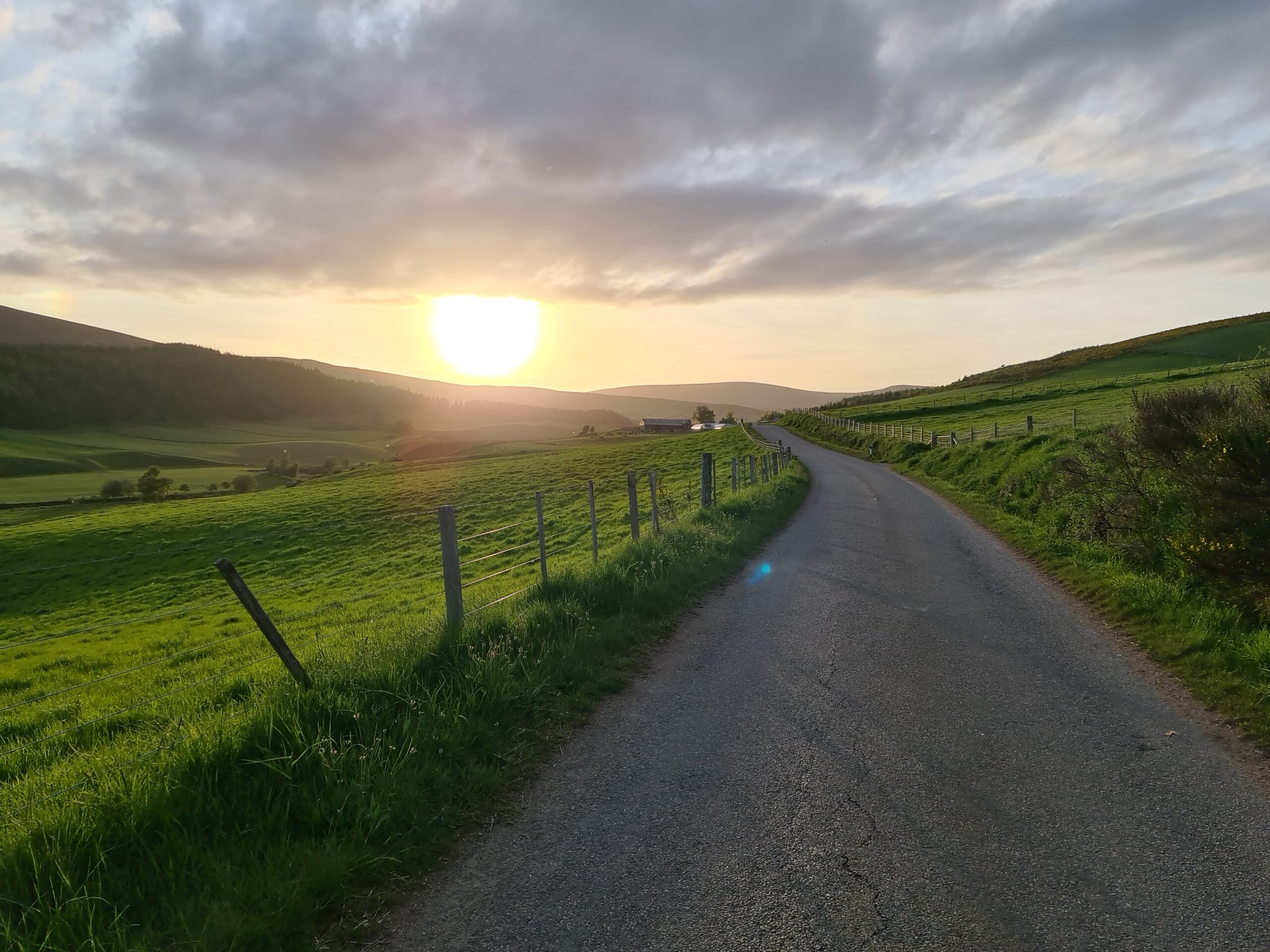
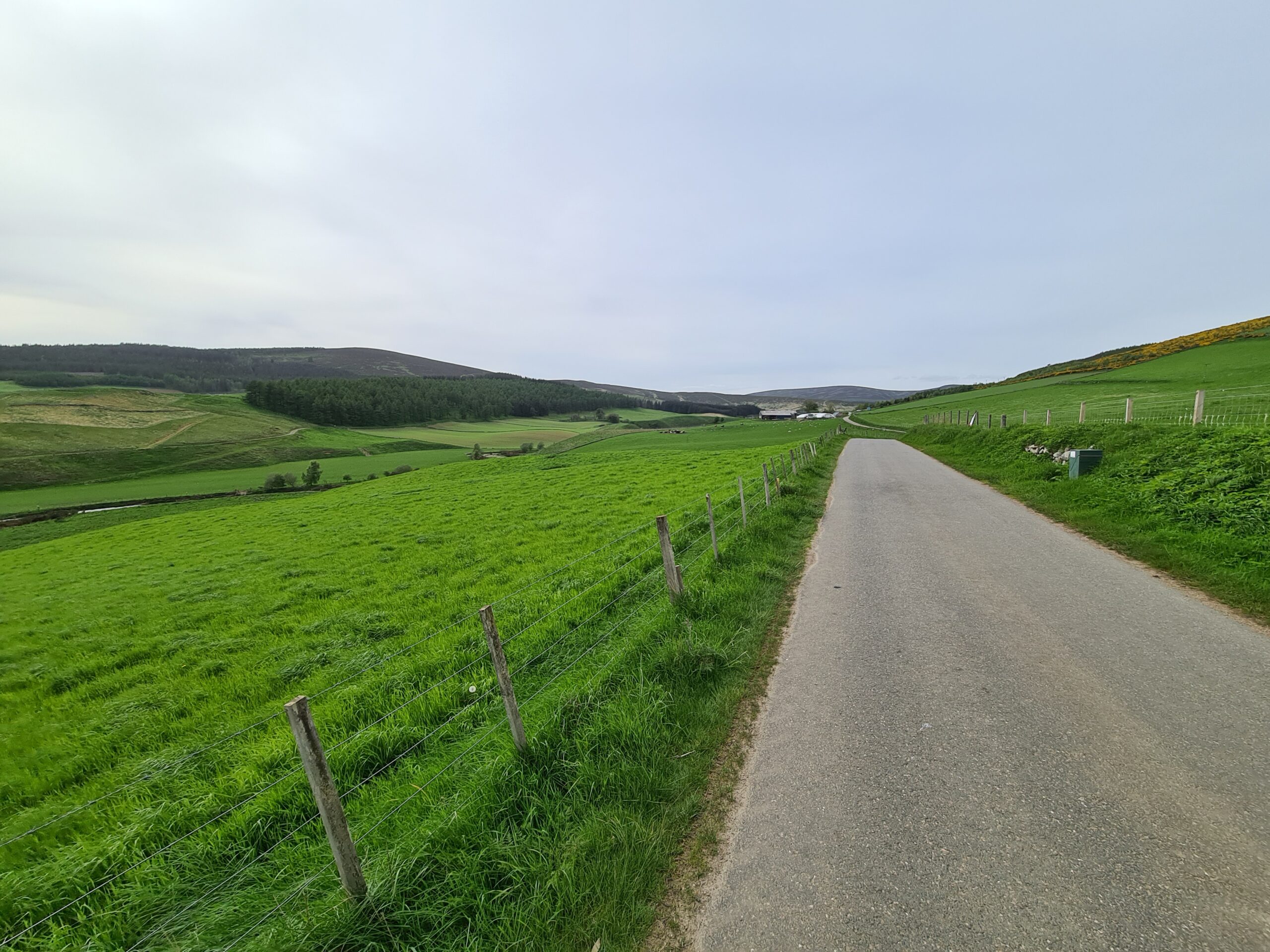

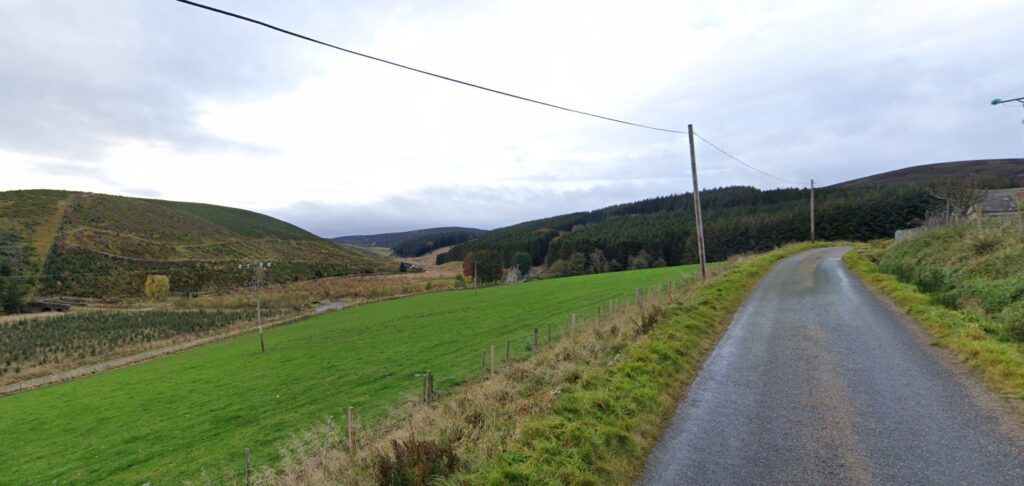


Aerial Drone Footage
Aerial 360 view of the glen (4k available in settings options).
Language of the Glen
Much to the chagrin of some on social media who delight in stating that Gaelic never existed in Aberdeenshire, it in fact had a strong foothold in Glen Nochty, and even at the time of the 1921 census there were still speakers recorded. Much of the landscape too is interwoven with Gaelic, though sadly many names have either had their meaning lost through time, or were not recorded. Indeed, Roy’s Military Map of 1754 has ten times more settlement names than today. A book by James MacDonald in 1900 on the placenames of West Aberdeenshire is a great help to find the original name of settlements and topographical features, especially their original Gaelic name and meaning – you can view it here
The Glen was at the borders of where Doric and Scots met the Gaelic Highland world where language shift would slowly have been witnessed over the years. You can see an example of this language shift in a tale recorded in ‘Deeside Tales’ about Ian Allanach.
Gàidhlig
An robh Gàidhlig ga bruidhinn san sgìre? Bhathar Gàidhlig ga bruidhinn gu dearbh ann an Gleann Nochtaidh agus ann an sgìre! Bha ainmean-àite agus ainmean pearsanta gu leòr ann anns na clàran..
Chì sinn a’ Ghàidhlig air seann mhapaichean. Aig a’ chroit ‘Tolduquhill’, chì sinn còig ceud bliadhna air ais ‘sloch(d)’ air mapa pont. Dà cheud bliadhna air ais ‘clais mhor’, ‘glac an lochan’ agus ‘tornachòr’. Anns a’ ghleann chì sinn tòrr ainmean-àite anns a’ Ghàidhlig, mar eisimpleir ‘Blàr nam muc’ agus ‘Coire Breac’. Tha fios againn gum b’ i a’ Ghàidhlig cànan làitheil na sgìre gu 1745.
Music and culture
Glen Nochty and the wider area were a hotbed of traditional music. The Reverend Scott collated these into the ‘Glenbuchat Ballads’. From a BBC Article :
One of the performers, Marc Ellington, said: “Aberdeenshire has been ‘mission control’ for our ballad resource for a couple of hundred years.”
He added: “Versions of some ballads have been recorded by people as wide-ranging as Bob Dylan and the Grateful Dead.
“They are a cornerstone of major cultural influences globally and we haven’t, I don’t think in Scotland, embraced these ballads enough.
“They are an amazing resource.”
BRAES of STRATHDON (trad)
As I was a-walking one morning in May
Doon by a bonnie braeside I fondly did stray
I spied a bonnie lassie, she wis standing her lane
She wis bleaching her claes on the braes o’ Strathdon
I stepped up tae her as I seemed for tae pass
Ye’re bleaching yer claes, my bonnie young lass
It’s twelve months and mair since I’ve had ye on my mind
Jist for tae get married if you are inclined
Tae marry, tae marry, I’m three time o’er young
Besides a’ you young men have flattering tongues
My faither and my mither they would baith angry be
If I was tae marry a rover like ye
Come a’ ye pretty fair maids, take a warning frae me
And never slight a young man for his poverty
For slighting of a young man I’m afraid ye’ll get nane
And single ye’ll wander the braes o’ Strathdon
Lonach
The Lonach Society was formed in 1823. The principal aims of the Society are the preservation of Highland dress and the Gaelic language; to support loyal, peaceable manly conduct and the promotion of social and benevolent feelings among the inhabitants of this district.
The Society was founded in 1823, by Sir Charles Forbes, 1st Baronet of Newe and Edinglassie. The tradition has continued with its current patron, his Great- Great-Great-Grandson Sir James Thomas Stewart Forbes of Newe, 8th Baronet. The Lonach Gathering features the Lonach Pipeband and the march of the Lonach Highlanders.
The Highlanders parade annually during the annual Lonach Highland Games and Gathering, held on the 4th Saturday of August, to officially open the games. At various points along the route from Bellabeg to Strathdon, the column stops for a “wee dram” (of Scotch whisky). This is led by the patron of the Lonach Highland and Friendly Society, part of the Forbes clan. Most of the men in Lonach are Forbes, although there is a section for the Wallace and Gordon clans as well, each with their own tartan.
The below video shows the Lonach Highlanders marching out of the Glen Nochty road past the SPA shop.
1580 – Pont Map
Rev Timothy Pont (c. 1560 – c. 1627) was a Scottish minister, cartographer and topographer. He was the first to produce a detailed map of Scotland. Pont’s maps are among the earliest surviving to show a European country in minute detail, from an actual survey.
The Pont Map, produced roughly 1580, is likely the first to depict Glen Nochty. Only Tolduquhill (listed as Toldawhily) is stated as well as Campbell’s hollow/ lair (Kaimbell Sloch Moir). It is interesting that Tolduquhill is given such prominence, and perhaps hints at a much larger site than is the case today.

1826 – Newspaper Article
Large Moor fires take hold, likely in the area around Duff Defiance.
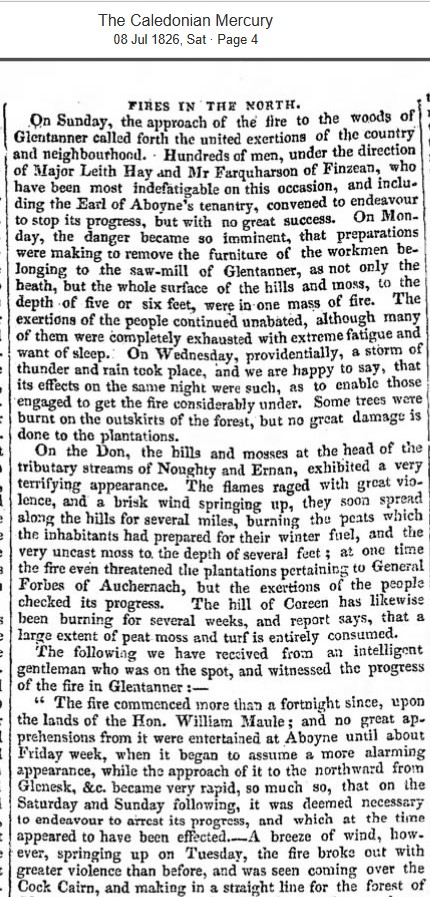
1844 – Corn Law Petition
Several residents of the glen are amongst a few thousand signing a petition appearing in the Aberdeen Journal in 1844 regarding the Corn Laws.


1854 – Newspaper Article
A discovery of an adder in the fireside of a Glen Nochty home makes the news in Liverpool.
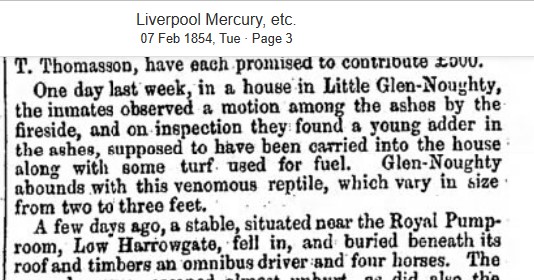
1854 – Newspaper Article
A large hawk is captured in a trap in Glen Nochty.

1854 – Newspaper Article
Celebrations for the birthday of the Lord Fife

1855 – Newspaper Article
A farmer’s son is attacked in a case of mistaken identity by a jealous lover.
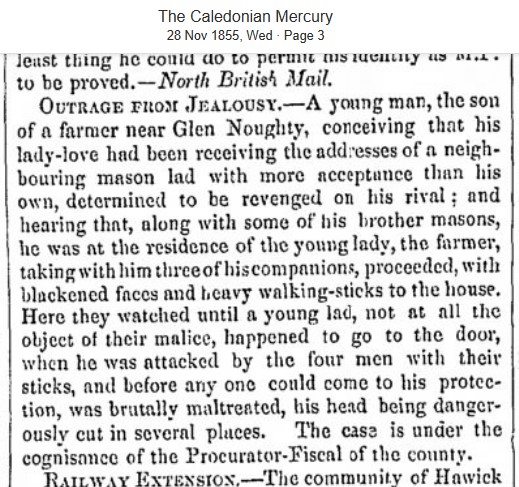
1860 – Newspaper Article
A climate reports states that snow has been on the ground for 23 weeks on the low ground, even more on the high, even into July.
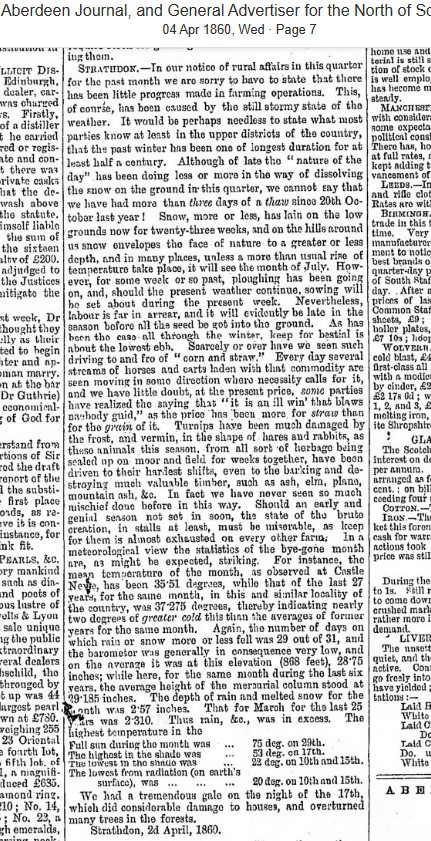
1860 – Newspaper Article
The below report suggests that illegal whisky distilling and smuggling were still very prevalent into the 1860s.

1869 – Newspaper Article
The Noughtyside Highlanders march from Glen Nochty to Braemar for the Games.
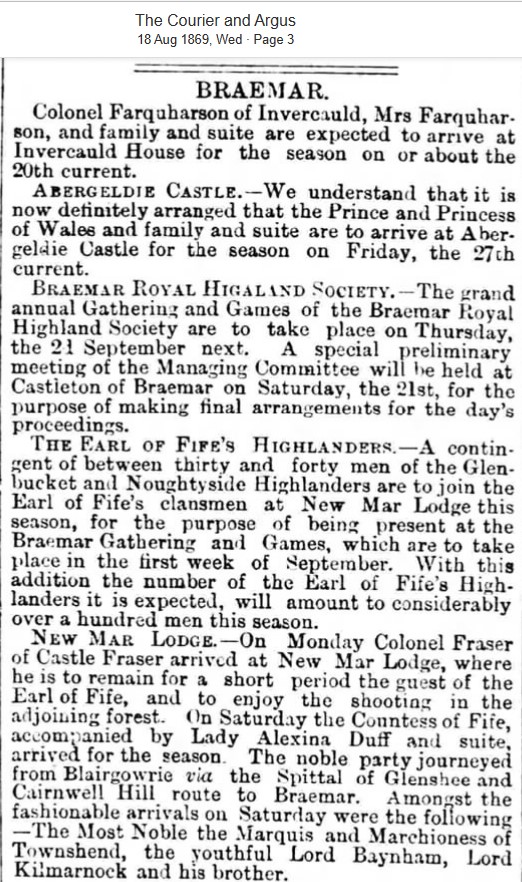
1882 – Newspaper Article
A person I would have loved to have met! William McPherson who collected local relics and worked in Glen Nochty dies in 1882 and the Courier and Argus paper gives an interesting account of his life.

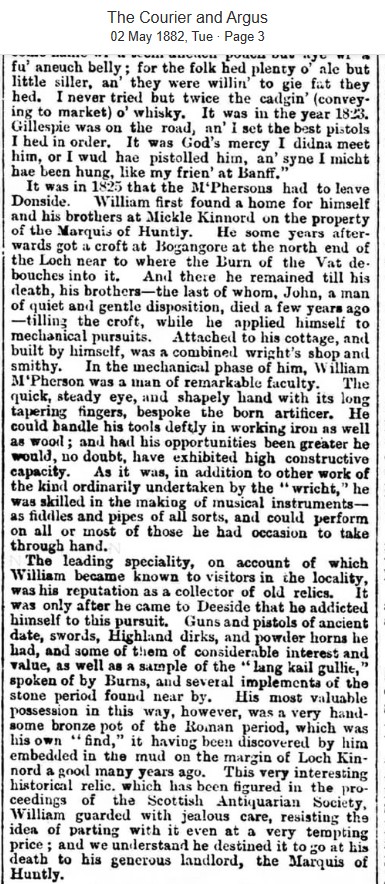
1884 – Newspaper Article
A newspaper reports on the same of the Earl of Fife’s estates.
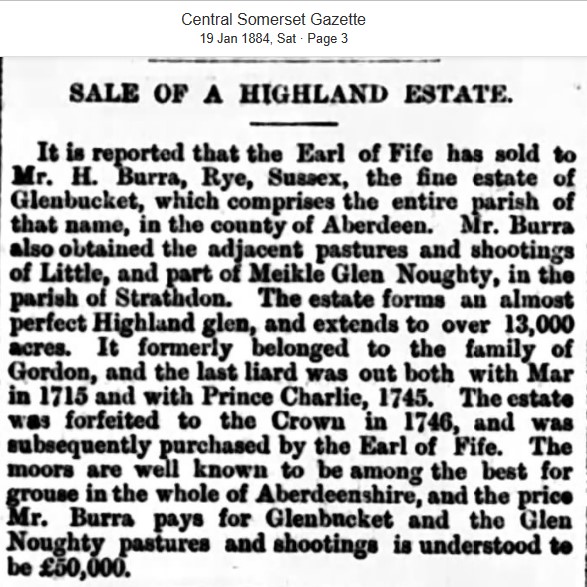
1886 – Newspaper Article
A meeting of the Farm Servants’ Movement takes place at Lonach Hall. I suspect that John taylor (using an alias Alex Taylor) who married Jean Allanach and wrote ‘Eleven Years a Farm Servant’ was the instigator.

1887 – Newspaper Article
A huge bonfire and party takes place on Rhinstock hill to celebrate Queen Victoria’s jubilee.

1892 – Newspaper Article
A group making their way through Glen Nochty with a coffin for a funeral forget to pay for drinks in Strathdon.

1899 – Newspaper Article
A delegation from Glen Nochty holds a presentation for Mr and Mrs Fletcher in Glenbucket.
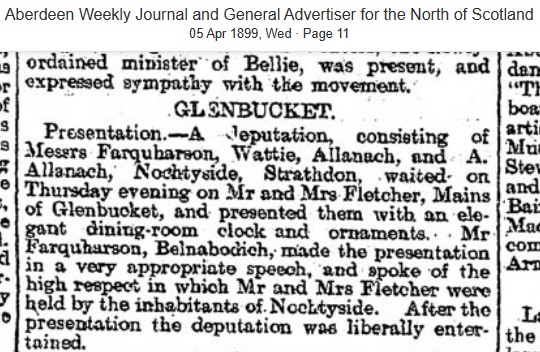
1920 – Poem
In 1920, renowned Scots Author Charles Murray publishes ‘In the Country Places‘ which includes the poem ‘In Lythe Strathdon’ and mentions Glen Nochty.
IN LYTHE STRATHDON
Seldom a simmer passed but him an’ me
Amang the hills had some fine cheery days,
Up Nochtyside or throu’ the Cabrach braes,
Doon the Lord’s Throat, an’ ootower Bennachie;
There wasna mony bare hill-heads onkent to him an’ me.
Never nae mair. I wander noo my leen,
An’ he’s been beddit lang in far Peronne ;
Here, whaur his forbears lie in lythe Strathdon,
I lay the stag-moss that I pu’ed yestreen—
Laurels fae Lonach, where I range oor auld hill tracks my leen.
1998 – Newspaper Article
Billy Connolly becomes a celebrity resident in Strathdon, includes an interview with former owner of Lost Gallery, Peter Goodfellow.

